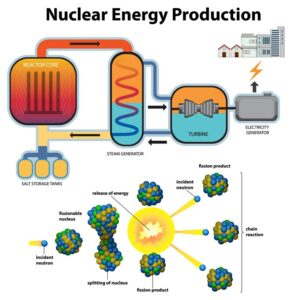Nuclear fusion is a process that could potentially revolutionize our energy systems, providing a clean, abundant, and efficient source of power. The process involves the fusion of two or more atomic nuclei, releasing vast amounts of energy. This is the same process that fuels stars, making them incredibly bright and hot. Fusion occurs when the atomic nuclei come close enough to overcome the electric repulsion between them, requiring extremely high temperatures and pressures.
The idea of harnessing nuclear fusion for electricity generation has been around since the 1930s, but it wasn’t until the 1950s and 1960s that researchers began to construct nuclear fusion reactors. Despite these early attempts, the reactors were inefficient and could not produce substantial energy. Over time, research into nuclear fusion technology accelerated, developing more efficient fusion reactors. The International Thermonuclear Experimental Reactor (ITER), the world’s largest fusion reactor, was established in the 1990s and is currently under construction in France. It is expected to be completed by 2025.
Nuclear fusion reactors are large machines designed to create and sustain fusion reactions. They typically consist of a containment vessel, a fuel source (often hydrogen or deuterium), and a power source such as an electrical current or a laser beam. These components are carefully designed and calibrated to ensure a sustained fusion reaction.

Recently, there have been several significant advances in nuclear fusion technology. For instance, in December 2022, a successful nuclear fusion ignition was achieved at the Lawrence Livermore National Laboratory in California. In this experiment, 192 of the world’s most energetic lasers heated a tiny pellet of hydrogen atoms, causing them to fuse to create helium and excess energy. The energy input was a little more than 2 megajoules, and the energy output was 3.15 megajoules, a modest gain of around 50% but a significant achievement nonetheless. However, the experiment has yet to be consistently replicated12345.
In addition to the National Ignition Facility’s achievement, other institutions worldwide are also making strides in nuclear fusion technology. For instance, the Large Helical Device in Japan, the world’s most significant superconducting plasma confinement device, achieved plasma temperatures of 100 million degrees in the 2020 fiscal year. The Massachusetts Institute of Technology (MIT) has been conducting fusion experiments since the 1970s and, in 2021, assisted Commonwealth Fusion Systems in creating a superconducting magnet that reached a field strength of 20 teslas, the most powerful ever created on Earth. Meanwhile, the Joint European Torus (JET) is the only machine globally equipped to handle a specific 50-50 mix of two hydrogen isotopes, which facilitates fusion at the lowest temperature and has the highest energy yield. This makes it the pathway toward more extensive fusion implementations6.
Despite these advancements, nuclear fusion faces several challenges. The cost of building and operating fusion reactors is high, with commercial-scale reactors estimated to cost billions of dollars. There are still significant knowledge gaps regarding creating and sustaining a fusion reaction. Scientists are also tasked with improving reactor efficiency and cost-effectiveness. Safety concerns must also be managed effectively, including high temperatures and pressures of fusion reactions. Moreover, the containment of the plasma (the hot, charged state of matter necessary for fusion) remains a significant challenge due to the incredibly high temperatures involved.
One of the most significant challenges is achieving and maintaining the conditions necessary for nuclear fusion. Fusion requires extremely high temperatures (tens of millions of degrees) and pressures to overcome the electrostatic forces that usually prevent atomic nuclei from coming together. Creating and maintaining these conditions in a controlled and stable manner is a substantial technical challenge.
Additionally, the materials used in the reactor must withstand the high temperatures and neutron radiation produced by the fusion reaction. Developing materials that can handle these conditions over the long term is a significant area of research in fusion technology.
Another challenge is the issue of energy balance. To be viable as an energy source, a fusion reactor must produce more energy than it consumes. While the recent experiment at Lawrence Livermore National Laboratory demonstrated a net energy gain, this is still a significant hurdle to overcome on a consistent and larger scale.
Despite these challenges, the potential rewards of nuclear fusion are enormous. Fusion reactions produce no greenhouse gases, and the fuel (hydrogen isotopes) is plentiful and widely available, making fusion a potentially sustainable and environmentally friendly energy source. The recent advances in fusion technology are promising and represent significant steps toward realizing the goal of harnessing fusion for power generation. However, much work remains to be done, and it will likely be several decades before fusion power becomes a practical reality.
Developing nuclear fusion as a viable energy source is an ongoing global effort involving many countries and research institutions. The recent breakthroughs are promising, but much research and development is still needed to make nuclear fusion a practical and reliable energy source. These efforts aim to achieve sustained and controlled nuclear fusion and make it economically viable and safe. While the timeline for achieving this is uncertain, the potential benefits of nuclear fusion make it a highly worthwhile pursuit.